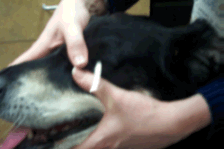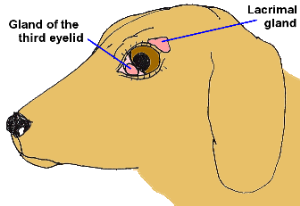Dry Eye (Keratoconjunctivitis Sicca) in Dogs and Cats
(Dry eye is formally known as keratoconjunctivitis sicca or KCS)
Why Tears are Good
We can all imagine the discomfort of dry, irritated eyes and the soothing that is provided by lubricating eye drops. Tears are essential to the comfort of our eyes but they do more than just provide lubrication. Tears contain anti-bacterial proteins and salts and serve to flush away the irritants and infectious agents that are constantly getting in our eyes. In addition, since the outer portions of the eye do not have a blood supply to remove metabolic waste, it is up to the tears to provide this service as well.

Diagram shows the two lacrimal (tear-producing) glands of the canine eye. Graphic by marvistavet.com
Tears consist mostly of water, but also of oil and mucus secreted by their respective eyelid glands. The water portion of tears is secreted by two lacrimal glands in dogs and cats: one just above the eye and another in the third eyelid (or so-called nictitating membrane).

Dry eye with the classical ropey discharge.
(Photo courtesy of Dr. Michael Zigler)
Without tears, eyes become irritated, the conjunctival tissues around the eyes get red, the cornea itself in time will turn brown in an effort to protect the eye, and a gooey, yellow discharge predominates. Blindness can result.
Keratoconjunctivitis sicca is a fancy way of saying the eye is dry. “Kerato” refers to the cornea or clear covering of the eye that faces the outside world.
“Conjunctivae” are the moist pink membranes of the eye socket. “Itis” means inflammation and “sicca” means dry. Keratoconjunctivitis sicca, abbreviated KCS, means there is an inflamed, dry cornea and conjunctiva. It occurs when there is a deficiency in the water portion of the tear film, which normally accounts for 95% of the tear volume. Without water, one is left with oil and mucus; hence, the gooey yellow eye discharge characteristic of this condition.
Why do Eyes Become this Dry?
There are many causes of dry eye. Some are:
- Canine distemper infection attacks all body interfaces with the environment including the eyes. Dry eye is part of the constellation of symptoms that can occur with canine distemper infection.
- In cats, herpes upper respiratory infection can lead to chronic dry eye (see more on herpes conjunctivitis).
- There could be a congenital lack of tear-producing gland tissue (as described in certain lines of Yorkshire terriers).
- Exposure to sulfa-containing antibiotics, such as trimethoprim-sulfa combinations, can lead to dry eye. It can be either temporary or permanent and occurs unpredictably.
- Anesthesia will reduce tear function temporarily (thus eyes are lubricated with ointment by the attending nurse).
- During surgery for cherry eye, removal of the third eyelid tear-producing gland, instead of replacing the gland in its proper location, can lead to KCS. So can too much damage to the gland prior to proper gland replacement.
- A knock on the head in the area of one of the tear-producing glands can lead to KCS.
- The most common cause of KCS appears to be immune-mediated destruction of the tear-producing gland tissue. We do not know what causes this type of inflammatory reaction but certain breeds are predisposed: the American Cocker Spaniel, the Miniature Schnauzer, and the West Highland white terrier.
How We Make the KCS Diagnosis
When KCS is in an advanced state, the situation is pretty obvious but early on in the case, it may look like a simple case of conjunctivitis. You may also notice a dry nose or nasal philtrum (area at the bottom of the nose). In either case, it is important to measure the tear production to determine how dry the eyes are.
The test that accomplishes this is called the Schirmer Tear Test.
To perform the test, a strip of specific paper is put just inside the lower eyelid in the outer corner of the eye and left for 60 seconds.

The moisture of the eye will wet the paper. At the end of the 60-second period, the length of the moistened area on the paper is measured. A length of 15mm or more is normal. A length 11 to 14mm is a borderline result. A height of less than 10mm is dry. A height less than 5mm is severely dry.

How do we Treat this Condition?
Not that long ago, all we had to treat this condition was tear replacement formulas and mucus-dissolving agents. These are still helpful but require an impractical frequency of administration. A breakthrough came with the discovery of cyclosporine topical therapy to control immune-mediated gland destruction.
Cyclosporine is an immunomodulating drug used to prevent organ transplant rejection in people and treat certain immune diseases in dogs and cats. When applied as an eye drop or ointment, it suppresses the immune destruction that is the most common cause of KCS, and tear production is restored.
The success of this treatment plus its convenient dosing interval (1 -3 times daily) has made this medication the primary treatment for KCS.
Animal hospitals used to make their own cyclosporine eyedrops out of oral cyclosporine and vegetable oil, but this largely ended when Optimmune® eye ointment (containing 0.2% cyclosporine) came out. Occasional patients simply do not show a good response to cyclosporine ointment but will respond when the concentration is increased. Higher-concentration products can easily be formulated by compounding pharmacies or one of the alternative medications listed below can be used. Treatment is almost always required for the lifetime of the pet.
After beginning cyclosporine eye drops or ointment, a recheck in three to four weeks is a good idea to check for improvement. If the Schirmer tear test is still showing poor results, the dosing frequency can be increased to three times a day; similarly, if excellent results are seen, the medication can be dropped to once a day. Periodic rechecks are needed for dose adjustment and some dogs take as long as three to four months to show a response. Dogs with Schirmer tear tests as low as 2 mm still have an 80 percent chance of responding to cyclosporine. This medication has been a miraculous breakthrough in the treatment of KCS.
Tacrolimus is another medication that is an immune modulator. No commercial products are available for use in the eye, so they must be obtained from a compounding pharmacy. It is often tried in cases that are unresponsive or poorly responsive to cyclosporine. It is used in a manner similar to cyclosporine and is generally similar in cost.
Pilocarpine is a cholinergic drug, which means it works on the autonomic nervous system (the part that controls automatic functions such as glandular secretion). This medication can be given for the particular form of dry eye known as neurogenic KCS. In these cases, neurogenic stimulation of the tear gland is absent, so the pilocarpine is given in an attempt to stimulate the gland. Although the drug comes as an eye drop, for KCS it is actually given orally at an increasing dose until side effects are seen (diarrhea, drooling, vomiting). If side effects are encountered, the dose is reduced to that which the animal tolerates. It is continued indefinitely or until the neurogenic KCS subsides, usually twice daily. Neurogenic KCS typically affects only one eye.
Artificial tear solutions, gels, and ointments can be purchased in most drug stores. These can be combined with other therapies and are soothing. Their use is particularly important early in therapy until cyclosporine or tacrolimus takes effect and in eyes that do not respond to these latter medications. Over-the-counter products may be recommended two-12 times daily, depending upon their formulation and the severity of the KCS.
Topical antibiotics are often needed, especially when starting treatment for KCS because secondary infections are common with inadequate tears. These products do not increase tear production but help relieve the thick discharge.
Topical steroids may be beneficial in decreasing the inflammation associated with KCS. Typically they are combined with topical antibiotics in the same solution or ointment, especially when given to dogs.
Surgical Solutions
Parotid duct transposition is a surgical solution to unresponsive, severe KCS, although it is a delicate procedure, usually done by a veterinary ophthalmologist. The parotid duct is the salivary gland on either side of the face/cheek. It produces saliva that is carried to the mouth via a long duct. This duct can be carefully dissected out and moved to the outer corner of the inside of the lower eyelid in order to deliver saliva to the eye. Saliva is a reasonable substitute for tears, although in time some mineral deposits may form on the eye surface. Mineralization of the cornea can range from mild to severe and there is no good way to predict whether mineralization will be a problem prior to the transposition of the duct. The eye may water uncontrollably when the dog is fed and facial wetting may be objectionable in some cases.




